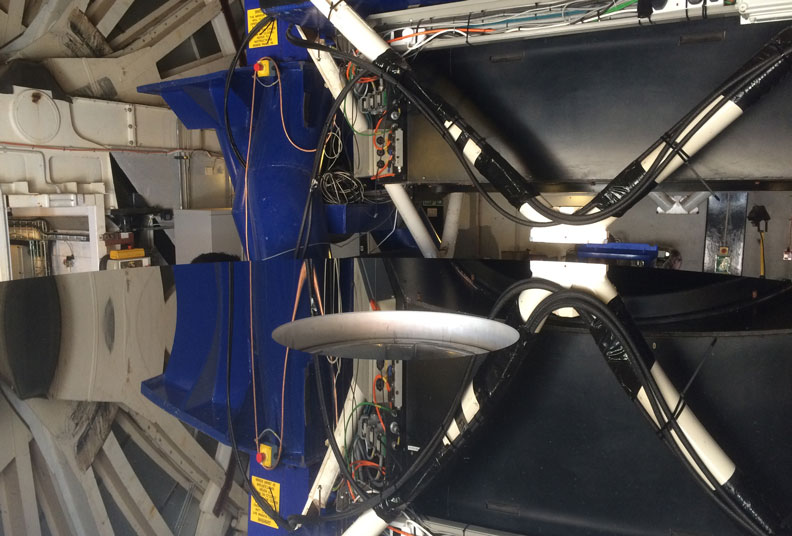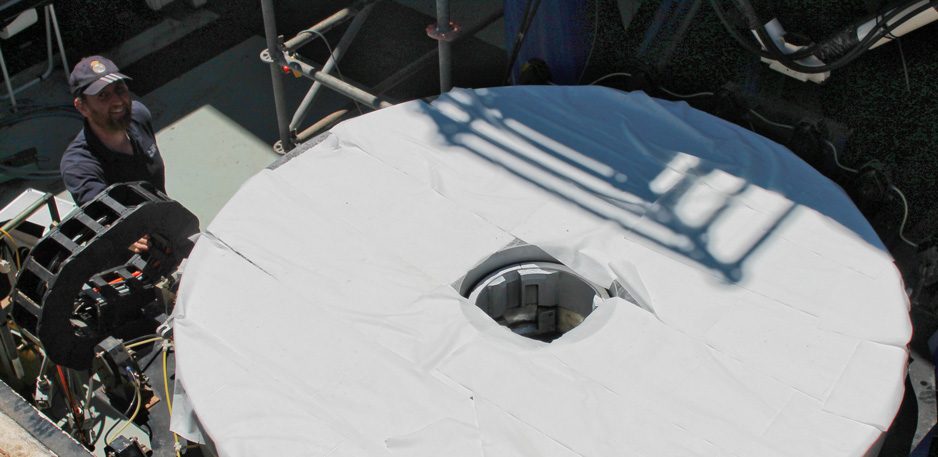UPDATES
- Wed 9th Oct: (Last update) All twilight flats obtained; data backlog rereduced and loaded to archive.
- Fri 4th Oct: Continuing to build up twilight flats for proper reduction. Fully-reduced data should be available in the first half of next week.
- Wed 2nd Oct: Recommissioning basically complete and observing robotically again. Fully-reduced data will be available for download in a few days, by which time a full set of flats should have been built up. In the meantime Quicklook versions of data are available now at https://telescope.ljmu.ac.uk/DataProd/quicklook/.
- Mon 30th Sep: Recommissioning begins today.
- Sat 28th Sep: Instrument refitting underway.
- Fri 27th Sep: Primary mirror back in telescope.
- 24-26th Sep: Maintenance work on other systems, including cassegrain rotator & primary mirror pneumatic support.
- Mon 23rd Sep: The primary mirror is at the WHT aluminising facility.
- Thu 19th Sep: The telescope is now offline.
The Liverpool Telescope (LT) will be offline in late September – early October while we realuminise the primary mirror.
The planned timeline for realuminising is:
- Wed 18th Sep: Last night of observing before realuminisation
- Thu 19th Sep: Telescope strip-down begins
- Mon 23rd Sep: Mirror removed and sent to aluminising facility
- Thu 26th Sep: Mirror returns and reassembly begins
- Mon 30th Sep: Recommissioning begins
- ~Thu 3rd Oct: Robotic operation resumes
The mirror will be removed from the LT and taken to the nearby aluminising plant at the William Herschel Telescope (WHT). Removing the mirror involves taking off all of the LT's instruments and dismantling the back of the telescope. Once the mirror is realuminised and the telescope and instruments reassembled, the process of recommissioning begins. The whole procedure is therefore quite involved and takes about two weeks, from instrument removal to resumption of robotic operations on-sky.
The procedure is talked about in a little more detail in a previous article written when the mirror was realuminised in 2015. Some aspects are adapted below for convenience, but for the complete historical article see "LT maintenance: mirrors realuminised and throughput doubled" (5th August 2015).
Realuminisation is necessary because the reflective part of the mirror, an incredibly thin layer of aluminium on the mirror's glass body, degrades over time. Humidity and other contaminants, especially dust from the Sahara desert, chemically attack the aluminium layer and reduces its overall reflectivity. Periodic cleaning is not 100% perfect, and after several years it's eventually better to take that aluminium off and put a fresh layer on.
The LT's primary mirror is a precision-crafted disc of glass two metres in diameter and 20cm thick, weighing in at 1.3 tonnes. Realuminising such a large and heavy piece of sensitive equipment without scratching it, or causing any damage at all, is a complex procedure:
- The primary mirror is slid out from underneath the telescope in its mirror cell and immediately covered in lint-free tissue to protect it and prevent dangerous reflections
- It's then carefully lifted off the mirror cell into a special padded transit box, and hoisted out of the top of the open enclosure to a waiting lorry. The lorry slowly and carefully takes the mirror the 500 metres to the aluminising plant at the WHT
- At the WHT, the mirror's aluminium layer is carefully removed with powerful acids, washed and carefully dried to ensure not a speck of dust remains on the surface
- The mirror is then put in the WHT's aluminising vacuum chamber where a new layer of pure aluminium is carefully evaporated onto the surface. The new layer is as thin as gold leaf, about 350 aluminium atoms deep. It measures just 100 nanometres (0.0001 mm) thick, or 160,000 times thinner than kitchen foil.
- The mirror is repackaged and carefully transported back to the LT. There it is hoisted back through the open enclosure, unpacked, and refitted to the telescope.
As touched on above, once the LT's many instruments are refitted, emphasis then focusses on recommissioning the telescope. Over several days and nights the telescope's engineering, optical and computer systems are all checked to make sure it's running autonomously again. Once we're happy, robotic operations recommence and an announcement is made on this website.
Updates will be posted at the head of this article during realuminisation.




